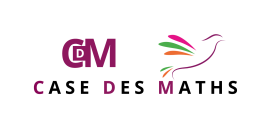Tex, pour utiliser le forum
-
Pour voir comment une formule a été écrite dans une question ou une réponse, y compris celle-ci, cliquez dessus avec le bouton droit de la souris et choisissez "Afficher les maths sous> Les commandes TeX". (Quand vous faites cela, le '$' ne s'affichera pas. Assurez-vous de les ajouter. Voir le point suivant.)
-
Pour les formules en ligne, incluez la formule dans
$...$. o -
Pour des formules centrées, utilisez
$$...$$.
Ceux-ci rendent différemment. Par exemple, tapez
$\sum_{i=0}^n i^2 = \frac{(n^2+n)(2n+1)}{6}$
pour voir $\sum_{i=0}^n i^2 = \frac{(n^2+n)(2n+1)}{6}$ ( qui est une formule en ligne ) ou tapez
$$\sum_{i=0}^n i^2 = \frac{(n^2+n)(2n+1)}{6}$$
pour voir $$\sum_{i=0}^n i^2 = \frac{(n^2+n)(2n+1)}{6}$$ ( qui est en mode displaystyle : formule centrée ). -
Pour les lettres grecques, utilisez
\alpha,\beta, …,\omega: $\alpha, \beta, … \omega$. Pour les majuscules, utilisez\Gamma,\Delta, …,\Omega: $\Gamma, \Delta, …, \Omega$. -
Pour les exposants et les indices, utilisez
^et_. Par exemple,x_i^2: $x_i^2$,\log_2 x: $\log_2 x$. -
Groupes. Exposants, indices, et autres opérations s'appliquent uniquement au prochain “groupe”. Un “groupe” est soit un symbole unique, soit une formule entourée d'accolades
{…}. Si vous tapez10^10, vous aurez une surprise: $10^10$. Mais10^{10}donnera probablement ce que vous voulez: $10^{10}$. Utilisez des accolades pour délimiter une formule à laquelle s'applique un indice ou un indice:x^5^6est une erreur;{x^y}^zdonne ${x^y}^z$, etx^{y^z}donne $x^{y^z}$. Observez la différence entrex_i^2$x_i^2$ etx_{i^2}$x_{i^2}$. -
Parenthses Ordinary symbols
()[]make parentheses and brackets $(2+3)[4+4]$. Use\{and\}for curly braces $\{\}$.These do not scale with the formula in between, so if you write
(\frac{\sqrt x}{y^3})the parentheses will be too small: $(\frac{\sqrt x}{y^3})$. Using\left(…\right)will make the sizes adjust automatically to the formula they enclose:\left(\frac{\sqrt x}{y^3}\right)is $\left(\frac{\sqrt x}{y^3}\right)$.\leftand\rightapply to all the following sorts of parentheses:(and)$(x)$,[and]$[x]$,\{and\}$\{ x \}$,|$|x|$,\vert$\vert x \vert$,\Vert$\Vert x \Vert$,\langleand\rangle$\langle x \rangle$,\lceiland\rceil$\lceil x \rceil$, and\lfloorand\rfloor$\lfloor x \rfloor$.\middlecan be used to add additional dividers. There are also invisible parentheses, denoted by.:\left.\frac12\right\rbraceis $\left.\frac12\right\rbrace$.If manual size adjustments are required:
\Biggl(\biggl(\Bigl(\bigl((x)\bigr)\Bigr)\biggr)\Biggr)gives $\Biggl(\biggl(\Bigl(\bigl((x)\bigr)\Bigr)\biggr)\Biggr)$. -
Sums and integrals
\sumand\int; the subscript is the lower limit and the superscript is the upper limit, so for example\sum_1^n$\sum_1^n$. Don't forget{…}if the limits are more than a single symbol. For example,\sum_{i=0}^\infty i^2is $\sum_{i=0}^\infty i^2$. Similarly,\prod$\prod$,\int$\int$,\bigcup$\bigcup$,\bigcap$\bigcap$,\iint$\iint$,\iiint$\iiint$,\idotsint$\idotsint$. -
Fractions There are three ways to make these.
\frac abapplies to the next two groups, and produces $\frac ab$; for more complicated numerators and denominators use{…}:\frac{a+1}{b+1}is $\frac{a+1}{b+1}$. If the numerator and denominator are complicated, you may prefer\over, which splits up the group that it is in:{a+1\over b+1}is ${a+1\over b+1}$. Using\cfrac{a}{b}command is useful for continued fractions $\cfrac{a}{b}$, more details for which are given in this sub-article. -
Fonts
- Use
\mathbbor\Bbbfor "blackboard bold": $\mathbb{CHNQRZ}$. - Use
\mathbffor boldface: $\mathbf{ABCDEFGHIJKLMNOPQRSTUVWXYZ}$ $\mathbf{abcdefghijklmnopqrstuvwxyz}$. - Use
\mathitfor italics: $\mathit{ABCDEFGHIJKLMNOPQRSTUVWXYZ}$ $\mathit{abcdefghijklmnopqrstuvwxyz}$. - Use
\pmbfor boldfaced italics: $\pmb{ABCDEFGHIJKLMNOPQRSTUVWXYZ}$ $\pmb{abcdefghijklmnopqrstuvwxyz}$. - Use
\mathttfor "typewriter" font: $\mathtt{ABCDEFGHIJKLMNOPQRSTUVWXYZ}$ $\mathtt{abcdefghijklmnopqrstuvwxyz}$. - Use
\mathrmfor roman font: $\mathrm{ABCDEFGHIJKLMNOPQRSTUVWXYZ}$ $\mathrm{abcdefghijklmnopqrstuvwxyz}$. - Use
\mathsffor sans-serif font: $\mathsf{ABCDEFGHIJKLMNOPQRSTUVWXYZ}$ $\mathsf{abcdefghijklmnopqrstuvwxyz}$. - Use
\mathcalfor "calligraphic" letters: $\mathcal{ ABCDEFGHIJKLMNOPQRSTUVWXYZ}$ - Use
\mathscrfor script letters: $\mathscr{ABCDEFGHIJKLMNOPQRSTUVWXYZ}$ - Use
\mathfrakfor "Fraktur" (old German style) letters: $\mathfrak{ABCDEFGHIJKLMNOPQRSTUVWXYZ} \mathfrak{abcdefghijklmnopqrstuvwxyz}$.
- Use
-
Radical signs Use
sqrt, which adjusts to the size of its argument:\sqrt{x^3}$\sqrt{x^3}$;\sqrt[3]{\frac xy}$\sqrt[3]{\frac xy}$. For complicated expressions, consider using{...}^{1/2}instead. -
Some special functions such as "lim", "sin", "max", "ln", and so on are normally set in roman font instead of italic font. Use
\lim,\sin, etc. to make these:\sin x$\sin x$, notsin x$sin x$. Use subscripts to attach a notation to\lim:\lim_{x\to 0}$$\lim_{x\to 0}$$ -
There are a very large number of special symbols and notations, too many to list here; see this shorter listing, or this exhaustive listing. Some of the most common include:
\lt \gt \le \leq \leqq \leqslant \ge \geq \geqq \geqslant \neq$\lt\, \gt\, \le\, \leq\, \leqq\, \leqslant\, \ge\, \geq\, \geqq\, \geqslant\, \neq$. You can use\notto put a slash through almost anything:\not\lt$\not\lt$ but it often looks bad.\times \div \pm \mp$\times\, \div\, \pm\, \mp$.\cdotis a centered dot: $x\cdot y$\cup \cap \setminus \subset \subseteq \subsetneq \supset \in \notin \emptyset \varnothing$\cup\, \cap\, \setminus\, \subset\, \subseteq \,\subsetneq \,\supset\, \in\, \notin\, \emptyset\, \varnothing${n+1 \choose 2k}or\binom{n+1}{2k}${n+1 \choose 2k}$\to \rightarrow \leftarrow \Rightarrow \Leftarrow \mapsto$\to\, \rightarrow\, \leftarrow\, \Rightarrow\, \Leftarrow\, \mapsto$\land \lor \lnot \forall \exists \top \bot \vdash \vDash$\land\, \lor\, \lnot\, \forall\, \exists\, \top\, \bot\, \vdash\, \vDash$\star \ast \oplus \circ \bullet$\star\, \ast\, \oplus\, \circ\, \bullet$\approx \sim \simeq \cong \equiv \prec \lhd \therefore$\approx\, \sim \, \simeq\, \cong\, \equiv\, \prec\, \lhd\, \therefore$\infty \aleph_0$\infty\, \aleph_0$\nabla \partial$\nabla\, \partial$\Im \Re$\Im\, \Re$- For modular equivalence, use
\pmodlike this:a\equiv b\pmod n$a\equiv b\pmod n$. \ldotsis the dots in $a_1, a_2, \ldots ,a_n$\cdotsis the dots in $a_1+a_2+\cdots+a_n$- Some Greek letters have variant forms:
\epsilon \varepsilon$\epsilon\, \varepsilon$,\phi \varphi$\phi\, \varphi$, and others. Script lowercase l is\ell$\ell$.
Detexify lets you draw a symbol on a web page and then lists the $\TeX$ symbols that seem to resemble it. These are not guaranteed to work in MathJax but are a good place to start. To check that a command is supported, note that MathJax.org maintains a list of currently supported $\LaTeX$ commands, and one can also check Dr. Carol JVF Burns's page of $\TeX$ Commands Available in MathJax.
-
Spaces MathJax usually decides for itself how to space formulas, using a complex set of rules. Putting extra literal spaces into formulas will not change the amount of space MathJax puts in:
a␣banda␣␣␣␣bare both $a b$. To add more space, use\,for a thin space $a\,b$;\;for a wider space $a\;b$.\quadand\qquadare large spaces: $a\quad b$, $a\qquad b$.To set plain text, use
\text{…}: $\{x\in s\mid x\text{ is extra large}\}$. You can nest$…$inside of\text{…}. -
Accents and diacritical marks Use
\hatfor a single symbol $\hat x$,\widehatfor a larger formula $\widehat{xy}$. If you make it too wide, it will look silly. Similarly, there are\bar$\bar x$ and\overline$\overline{xyz}$, and\vec$\vec x$ and\overrightarrow$\overrightarrow{xy}$ and\overleftrightarrow$\overleftrightarrow{xy}$. For dots, as in $\frac d{dx}x\dot x = \dot x^2 + x\ddot x$, use\dotand\ddot. -
Special characters used for MathJax interpreting can be escaped using the
\character:\$$\$$,\{$\{$,\_$\_$, etc. If you want\itself, you should use\backslash$\backslash$, because\\is for a new line.
(Tutorial ends here.)
- Vues: 5487
